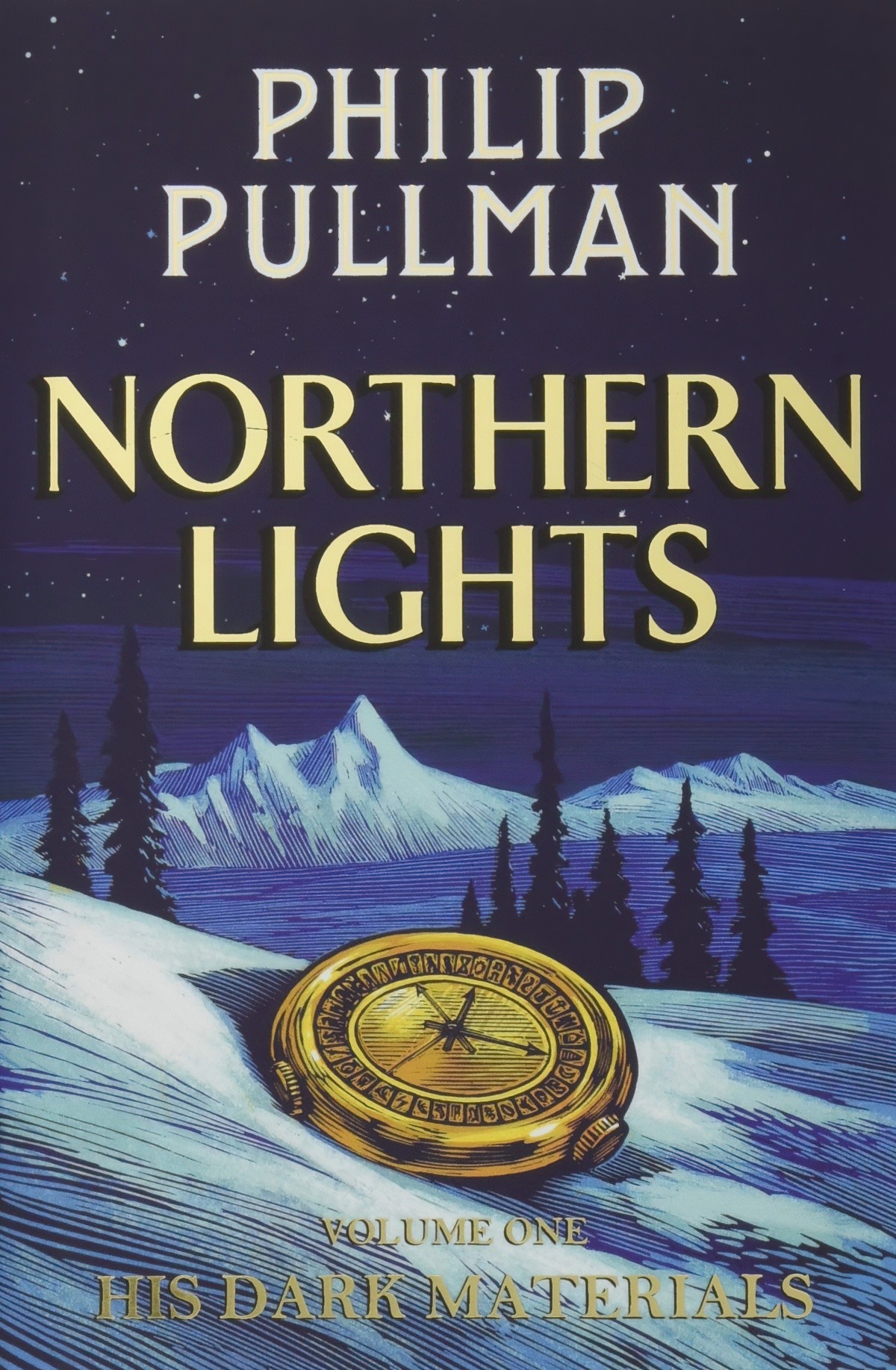Northern Lights is a young adult story with broad appeal for adults. The plot follows mythic structure.
Northern Lights has been adapted into a film (2007) and also into an action/adventure puzzle game (by Sega). While in some cases films can be just as enjoyable — or even more enjoyable — than the books upon which they are based, that is nowhere near true in this case. There are many reasons for this which resulted from too many cooks spoiling the broth. Not least:
Before its release, the film received criticism from secularist organisations and fans of His Dark Materials for the dilution of elements of the story which were critical of religion, as well as from some religious organisations for the source material’s anti-Catholic themes. The studio ordered significant changes late in post-production, which Weitz later called a “terrible” experience.
Wikipedia
Ideology
There is no god, or if there is, things aren’t as black and white as the Christian idea of heaven vs hell would have children believe. In reality people are both ‘good’ and ‘bad’. Our viewpoint character, Lyra, is a natural atheist, regarding stories from the Bible as symbols rather than truths:
“And that was how sin came into the world, ” he said [after reading the story of Adam and Eve], “sin and shame and death. It came the moment their daemons became fixed.”
“But…” Lyra struggled to find the words she wanted: “but it en’t true, is it? Not true like chemistry or engineering, not that kind of true?” There wasn’t really an Adam and Eve? The Cassington Scholar told me it was just a kind of fairy-tale.”
People use religion as a means to gain power.
“You see, your mother’s always been ambitious for power. At first she tried to get it in the normal way, through marriage, but that didn’t work, as I think you’ve heard. So she had to turn to the Church. Naturally she couldn’t take the route a man could have taken — priesthood and so on — it had to be unorthodox; she had to set up her own order, her own channels of influence, and work through that. It was a good move to specialize in Dust. Everyone was frightened of it; no one knew what to do; and when she offered to direct an investigation, the Magisterium was so relieved that they backed her with money and resources of all kinds.”
Working hard gives you purpose in life.
Now that Lyra had a task in mind, she felt all very well, but Pantalaimon was right: she wasn’t really doing any work there, she was just a pretty pet. On the gyptian boat, there was real work to do, and Ma Costa made sure she did it. She cleaned and swept, she peeled potatoes and made tea, she greased the propellor-shaft bearings, she kept the weed-trap clear over the propellor, she washed dishes, she opened lock gates, she tied the boat up at mooring-posts, and within a couple of day sshe was as much at home with this new life as if she’d been born gyptian.
The appearance of perfection is empty and its pursuit will lead you astray.
Setting
Religion
It’s well-known that Pullman wrote this His Dark Materials trilogy as an antidote to the Narnia Chronicles by C.S. Lewis.
A dogmatic ruling power called the Magisterium opposes free inquiry.
Ever since Pope John Calvin had moved the seat of the Papacy to Geneva and set up the Consistorial Court of Discipline, the Church’s power over every aspect of life had been absolute. The Papacy itself had been abolished after Calvin’s death, and a tangle of courts, colleges, and councils, collectively known as the Magisterium, had grown up in its place. Those agencies were not always united; sometimes a bitter rivalry grew up between them. For a large part of the previous century, the most powerful had been the College of Bishops, but in recent years the Consistorial Court of Discipline had taken its place as the most active and the most feared of all the Church’s bodies.
But it was always possible for independent agencies to grow up under the protection of another part of the Magisterium, and the Oblation Board, which the Librarian had referred to, was one of these.
Consistorial: An assembly of cardinals presided over by the pope for the solemn promulgation of papal acts, such as the canonization of a saint.
Type Of Fantasy World
The world of The Golden Compass is a world very much like ours, in a parallel universe. Much of it would be familiar to us — the continents, the oceans, Brytain, Norroway and The North Pole — but much is shockingly different. On this parallel Earth, a person’s soul lives on the outside of their body, in the form of a daemon — a talking animal spirit that accompanies them through life. A child’s daemon can change shape, assuming all the forms that a child’s infinite potential inspires; but as a person ages, their daemon eventually settles into one form, according to their character and nature.
— from a glossary of a promotional adaptation based on the film for Nestle Breakfast Cereals called The Golden Monkey and the Duel of the Daemons
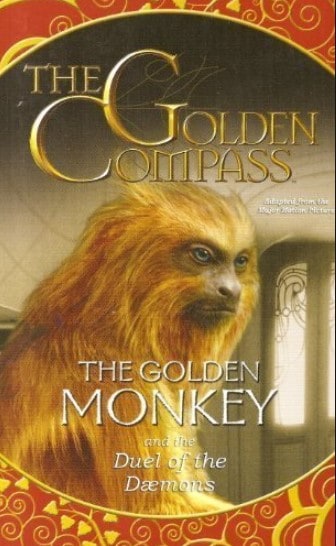
This is an example of ‘low fantasy’, along with Tom’s Midnight Garden and, of course, The Lion, The Witch And The Wardrobe.
Low fantasy is a subgenre of fantasy fiction involving “non-rational happenings that are without causality or rationality because they occur in the rational world where such things are not supposed to occur.” Low fantasy stories are usually set in a fictional but rational world, and are contrasted with high fantasy stories, which take place in a completely fictional fantasy world setting with its own set of rules and physical laws.
Wikipedia
So we find that the world of Northern Lights is set upon a palimpsest of England and Northern Europe, with familiar names such as London, Oxford and Whitehall, Lapland, Berlin and Svalbard.
Lyra herself (in a close third person narrative moment) regards the subterranean area as ‘the netherworld’. It’s no coincidence that she and Roger find dead bodies down here. As mentioned below, with Lyra’s hobby of roof jumping, Pullman creates an expansive world that not only has great latitude but also makes full use of altitude.
Ghosts
As in Philippa Pearce’s Tom’s Midnight Garden, this is an England where ghosts are real. When Lyra interferes with the skulls in the crypt, headless bodies enter her room at night to torment her. It is left up to the reader to decide whether this was real within the setting or if it is Lyra’s dreamscape.
Technology
This is almost a steampunk world. Instead of photographs we have magical photograms. Photograms are real things but in this world they can function magically so long as you use the right emulsion to develop the film. People have lorgnettes instead of spectacles (a pair of glasses or opera glasses held in front of a person’s eyes by a long handle at one side.)
Alethiometer
This is Pullman’s creation, inspired by the real world compass.
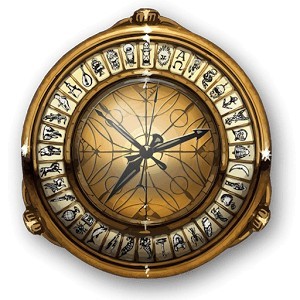
The word ‘alethic’ is a philosophical term denoting modalities of truth such as necessity, contingency, or impossibility. It’s basically a ‘truth-o-meter’.
“Dust”
The concept of dust is mentioned throughout the book and we are left to wonder what it is. It is revealed at the end to be connected to our real world, probably similar to how ‘dark matter’ or ‘junk DNA’ will eventually be proven to be something far more complex than we’d assumed, like how ‘bad air’ was later discovered to be a mosquito-borne virus, malaria.
Dust is revealed to be an elementary particle, thought to be evidence of Original Sin.
“But think of Adam and Eve like an imaginary number, like the square root of minus one: you can never see any concrete proof that it exists, but if you include it in your equations, you can caluclate all manner of things that couldn’t be imagined without it.
“Anyway, it’s what the Church has taught for thousands of years. And when Rusakov discovered Dust, at last there was a physical proof that something happened when innocence changed into experience.
“Incidentally, the Bible gave us the name Dust as well. At first they were called Rusakov Particles, but soon someone pointed out a curious verse toward the end of the Third Chapter of Genesis, where God’s cursing Adam for eating the fruit.”
Social Structure
It’s no accident that Lyra is a girl, not the default boy. Some authors create a girl protagonist for the reason of equal representation, as a move against symbolic annihilation, but another reason for creating a girl hero is because femaleness can be part of her underdog-ness, and an audience loves an underdog.
The reason Lyra is an underdog is because she lives in a patriarchy, similar to that found in England a few decades ago, where only (white) men were to be found in the halls of Oxbridge. There are a few token women, but they do not have equality:
“Are you a female Scholar?” said Lyra. She regarded female Scholars with a proper Jordan disdain: there were such people but, poor things, they could never be taken more seriously than animals dressed up and acting a play.
As in any unequal society, there is a strong caste system, with Scholars and politicians and royalty at the top and the servant class much further down (they all have dogs as daemons). Below them are the homeless and the travellers.
Animals
Pullman’s daemons (pronounced ‘demons’) are like spirit animals. They accompany characters everywhere, every character has one, and they can change form depending on the circumstance. At least, that is true for children. As children become adults their spirit animal settles into one creature. This is obviously symbolic of how we all grow more like ourselves as we grow older and figure out who we are.
This view of ‘concrete adult personality’ has been a dominant in psychology, at least in pop psychology, throughout recent history, though recent research suggests it’s not true at all. In February 2017 the results from the longest ever personality study revealed that our personalities when measured at the age of 77 are completely unrecognisable from those of our 14-year-old selves.
It is interesting to meet all the different forms that Pan takes on, and the animals of other characters’ daemons. Most writers are heavily influenced by Aesop when borrowing the animal tropes. Pullman makes use of standard animal characterisations but is highly original in both his choice of animal and which part of Lyra’s personality they represent.
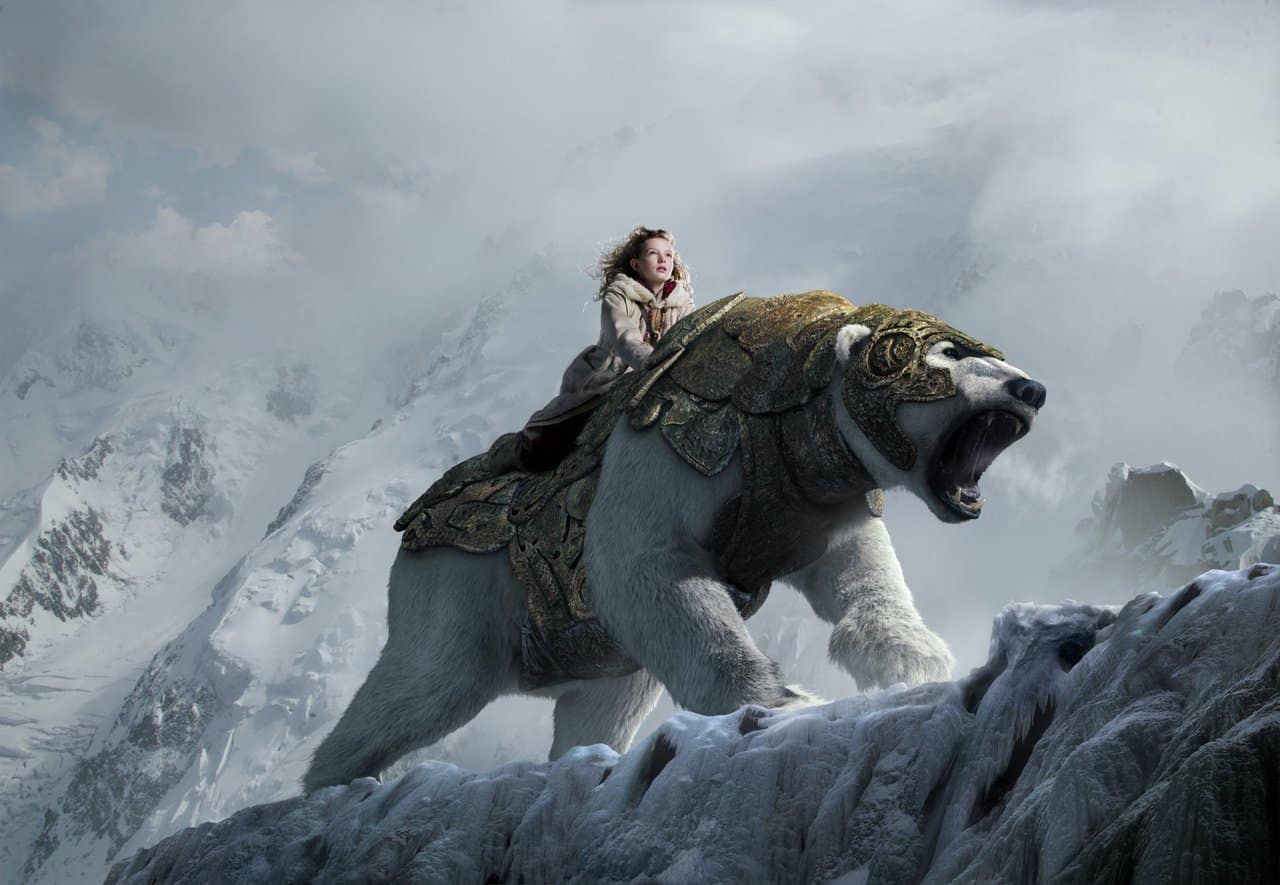
STORY STRUCTURE OF NORTHERN LIGHTS
Shortcoming/Need/Problem
Lots of children’s books star ‘the every boy’ or ‘the every girl’. This is someone without distinct features. The reader — or often the middle class white reader — is then able to paste themselves over top, embodying the fictional character. Bella Swan is a good example of the featureless ‘every girl’.
Here we have a completely different heroine. Lyra goes beyond the every girl. Lyra Belacqua is a full-on rascal, “half-wild, half-civilised”, an implied orphan at the beginning:
- Even though she hasn’t reached puberty she drinks and smokes. The drink is stolen and she’s not sorry for it even when she throws up.
- She is engaged in petty warfare with whatever rival gang seems the most fun. She doesn’t think why she’s doing it.
- She has some AD/HD qualities — she doesn’t sit still and listen when the Scholars try and tell her things, and when they do, it’s in one ear and out the other. These types of girls make very interesting protagonists and we see them a lot in middle grade fiction because they are fun. They are unafraid of adventure, and indeed crave it.
- Lyra is a natural leader. She’s the decider in her ‘pack’ of friends, not just because she has noble blood but because that’s her personality.
So Lyra has very clear moral shortcomings: She lives her life in the name of fun even when others are at the butt end of her bullying. She is a renegade, which will come in handy later but for now means she steals and wrecks her health.
Lyra needs to learn which big struggles are worth fighting, and it’s not throwing rocks at the travellers’ kids who come into town. It is only when her best friend Roger gets abducted that she realises this is serious.
The reader already knows that Lyra is a Chosen Hero, much like Harry Potter, because we’ve been privy to the conversation between The Master and the Librarian after the failed poison attempt. The reader is clued-in to the fact that Lyra will succeed in her preordained mission.
Desire
At the beginning of the story Lyra’s only desire is to have fun. She is a natural explorer and very curious, so she explores the environment from the roofs and when she learns about the underground she goes down there, too. With her friend Roger she is trying to locate Gobblers, who to her are almost a kind of mythical creature.
However, when the Gobblers take Roger, shit gets real, and Lyra’s Strong Storyline Desire kicks into action. Not insignificantly, her doubling down happens on top of a roof. In stories revelations and decisions often take place in high places. It’s from the Bible. (Moses on the Mount.) It’s on the roof that she decides to go in search for Roger.
Pullman makes full use of the ups-and-downs of the geography, first with Lyra playing on the rooftops, next with she and Roger exploring the secret passages of Oxford, which her uncle tells her is just as expansive as what’s above ground.
When characters go onto rooftops, this is symbolically very similar to flying.
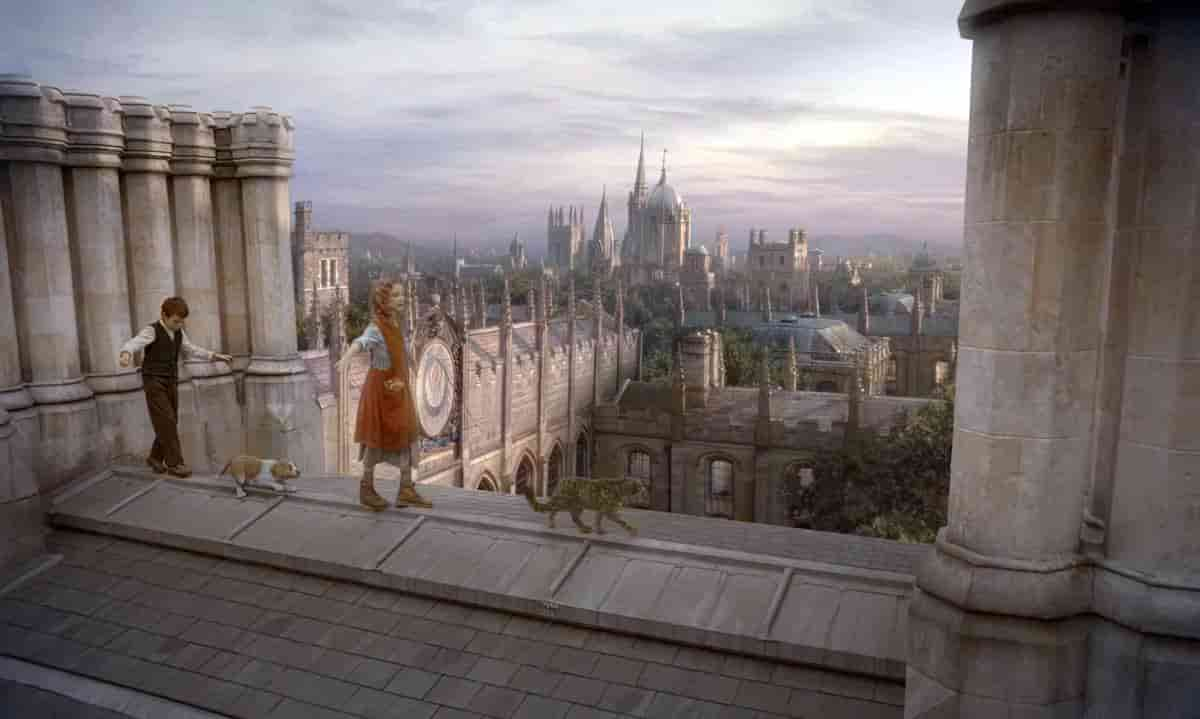
Opponent
Lyra’s life is turned upside down when children start to go missing, kidnapped by the enigmatic “Gobblers”, culminating in the disappearance of her best friend Roger.
We find the full range of villainy in this series, from morally ambiguous to out-and-out-evil, even if the evil is simply in the minds of the populace.
The mythical opponent — the out-and-out evil — is the group of Gobblers, who the reader knows from the outset is not exactly how Lyra understands it.
One thing Pullman does spectacularly well is presenting the adults in Lyra’s life as rounded people with both good and bad points, even when they get not much more than a single scene or a thumbnail character sketch.
- Lord Asriel is a scary but admirable uncle.
- The Master tries to kill Lord Asriel, but because we see him in discussion with the Librarian, his decision to kill Asriel is actually because he believes it’s for the greater good. He is not a classic villain, who in literature is bad because he wants to rule the world.
Pullman’s presentation of a yin and yang type universe is part of the deeper theme that there is no good/evil dichtomy. There is no heaven vs hell. It is far more complicated than that. People are far more complicated than that.
Mystery
Even in children’s books which are not of the mystery genre per se, mystery is a natural part of childhood and is therefore a natural part of stories about children. Remember what it’s like being a kid, overhearing adult conversations, standing in the shadows, and trying to work things out because adults don’t tell you things. And even if they do tell you things, you only understand part of it anyway. In this story, Lyra’s education is incomplete, she is pre-adolescent and a faulty memory. She pieces things together at the same rate as the reader.
Pullman is a master at introducing a tidbit then waiting before explaining what’s going on. He applies it to features of this fantasy world:
- What is dust?
- What is going on in the North that involves children?
- Why are children going missing and what is happening to them once they’re gone?
- What exactly are the Gobblers? This subplot draws on the nature of childhood rhymes such as Wee Willy Winky and folktales such as The Pied Piper. Pullman also understands the nature of urban legend, and we eventually learn where the name Gobbler came from, and who is behind the organisation.
- What is the alethiometer for? Pullman shows us first, describing only what it looks like as it’s given to Lyra. Next it is pointed out that because it ends in ‘meter’ it’s for measuring something. We learn that only six of them were made. We learn that everyone wants it and it is very precious. Finally Lyra meets people who tell her (and us) exactly what it’s for.
He applies mystery to character:
- Who are the baddies and who are the goodies?
- Who are Lyra’s parents?
- Who is this mysterious Mrs Coulter?
Plan
Lyra goes with the flow until she realises that Mrs Coulter is not all sweetness, as it says on the package. Lyra runs away and is taken in by the Gyptians. She decides to accompany the Gyptians to the wild and dangerous North.
Other characters have their own plans of course. For example, her father plans to build a bridge into a new world through the Northern Lights, where the barrier between the worlds is thin. Each of the main characters has a specific goal.
Big Struggle
There are a number of confrontations, ending in the fight to the death between the bears as climactic big struggle. At least, we think that’s the main big struggle — it is a big struggle scene in the most literal sense and we think that’s the final shock we’re going to get. That’s why we’re not prepared for Lyra’s father suddenly severing Roger’s daemon from him.
Anagnorisis
The mystery is tied up and the reader learns the truth about the Gobblers and the Dust: LAt the Northern research station the Gobblers undertake a process called “intercision”, forcibly separating children from their dæmons. This cruel operation supposedly protects children from Dust, the obsession of the civilised world but a mystery to Lyra.
Lyra also learns after a crash landing that Iorek is the rightful king. She manages by trickery to win back the throne from the false king, Iofur Raknison, who had allied the bears with the Gobblers.
She learns after getting away from her wicked mother the second time that she is capable of great things — Lyra is an excellent trickster and it will be up to her to save these children and uncover truths.
Early in the book Lyra mentions that she has an advantage over adults: She has a daemon who can change, whereas adults have a daemon who is set. That gives her an advantage as a child.
Stories don’t generally feature characters with transmogrifying animal daemons, of course, but the idea that children are malleable and adaptable and resilient to change is a common one throughout children’s literature. Their resilience is one main advantage they have over their adult opponents.
New Situation
Overwhelmed by guilt after unwittingly assisting her father in killing Roger, Lyra resolves to find Dust herself, reasoning that if her mother thinks it is a bad thing then the opposite must be true. She and Pan follow Lord Asriel into the new world.
